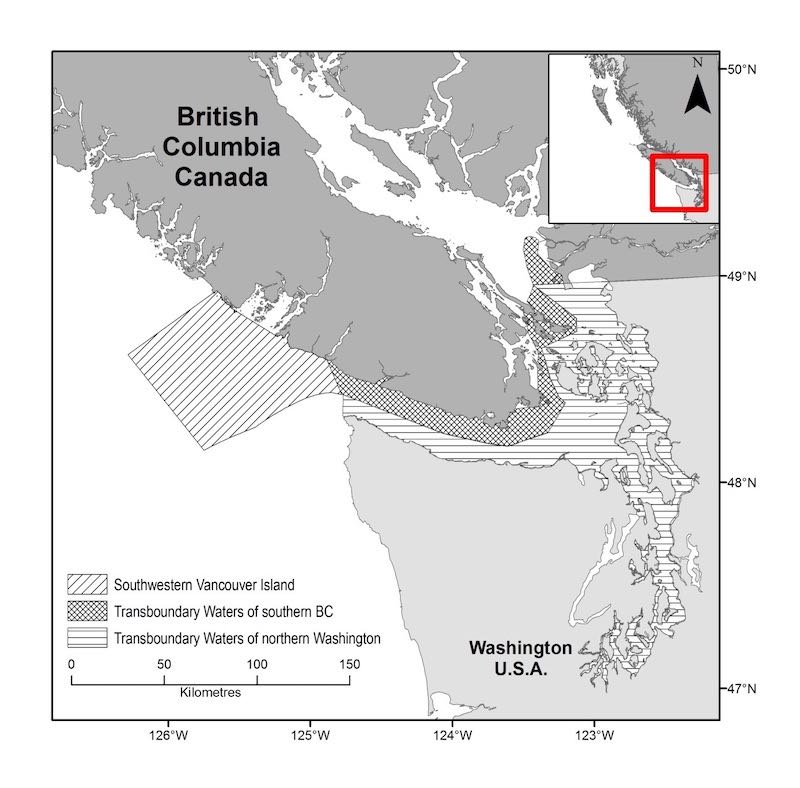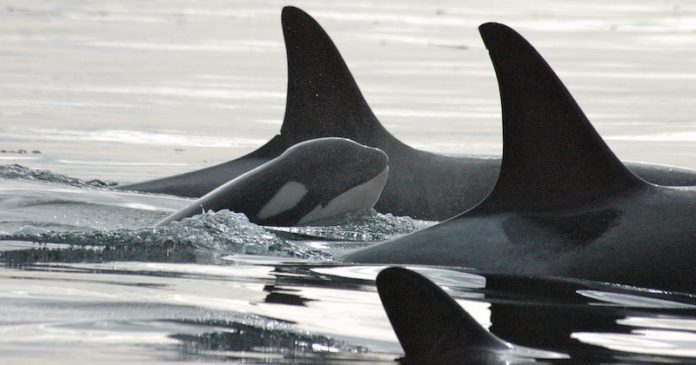On December 19, 2018 the DFO announced formal notice of intent to publish critical habitat (CH) orders for both Northern and Southern Resident Killer Whales under the Species at Risk Act (SARA). Southern Resident Killer Whales (SRKW) were listed as “Endangered,” and Northern Resident Killer Whales are listed as “Threatened.”
The area defined as new critical habitat comprises 5,025 square kilometers of Swiftsure and La Pérouse Banks off the west coast of BC. This is an offshore area stretching from Port Renfrew all the way up to Long Beach halfway between Ucluelet and Tofino. It extends out as far as 60 kilometers in the La Pérouse section.

These same areas are very important recreational and commercial fishing areas and represent a significant number of boat days each year. The scientific basis for designating these areas as CH lacked significant data showing that killer whales actually utilize these areas directly. Local and indigenous knowledge was not consulted; had it been, the department scientists would have learned that killer whales are rarely observed in much of the area now designated as CH.
There is no turning back now—the decision has been rendered and a CH designation order has been issued. What next?
People might immediately believe that this CH designation automatically means there will be large area closures similar to what we experienced in 2018 when fin fishing closures were implemented in broad areas. That is not necessarily the case; in fact, it is highly doubtful that new management measures will result in widespread area closures impacting the recreational fishery. Why?
Several groups came together during the public engagement on the critical habitat area while it was a public proposal. Those groups offered the fisheries minister and DFO compelling, science-based rationale challenging the accuracy of the DFO’s science advice and providing a new perspective on the social and economic benefits the recreational fishery provides to Canada’s GDP. The minister learned that recreational fishing for salmon in tidal waters generates more than $1 billion in economic activity. For many small coastal communities that rely almost completely on the recreational fishery, area closures are devastating.
The core message to the minister was that there are alternative management measures that can be applied in CH areas that achieve viable protection for whales, while also allowing responsible use so that recreational and commercial fisheries can successfully co-exist sharing these areas.
The minister and DFO have acknowledged significant economic benefits resulting from the recreational fishery could be placed at risk if we repeated similar measures to those implemented in 2018.
To that end, the department has now initiated five technical working groups (TWGs), comprised of science experts and indigenous, recreational, commercial, and NGO subject matter experts to work on specific issues identified as threat pillars impeding SRKW recovery. The TWGs will be developing recommendations for March 1 on short-term measures to be implemented in May of 2019. They will also develop long-term measures for June of 2019.
Issue 1: Prey availability and accessibility
This TWG will review measures implemented in 2018 and identify potential measures for the 2019 season. They will also contribute to identifying measures to rebuild wild Chinook stocks, prioritizing those of greatest importance to SRKW, keeping in mind the objectives of the DFO’s wild salmon policy.
Issue 2: Identification and development of proposed sanctuaries
This TWG will advance feasibility work on one or more SRKW sanctuaries—those being areas where boundaries to define where vessel traffic activity will be restricted or permitted within sub-areas of CH
Issue 3: Vessel noise—commercial vessel noise measures (slowdown/lateral displacement)
This TWG will review the effectiveness of 2018 measures, and identify those for 2019 including extension of slowdown measures. It will also identify infrastructure required to effectively monitor compliance and education promotion to support the measures.
Issue 4: Vessel noise—general noise measures
This TWG will identify noise reduction targets and options for quiet-vessel design and other noise reduction measures for commercial vessels and ferries. It will also identify measures to reduce noise impacts of commercial whale watching and recreational vessels.
Issue 5: Contaminants
This TWG will develop a framework to assess effectiveness of existing controls on contaminants affecting SRKW. It will also identify key contaminants and evaluate contribution of sources of contaminant loadings to SRKW, their habitat, and their prey. The TWG will develop recommendations for additional measures to address those contaminants.
The TWGs will also be asked to consider the orca recovery plan Washington State has adopted. Washington governor Jay Inslee asked Canada to align management measures as closely as possible given the close proximity and vessel activity overlap.
The recreational community strongly supports implementation of SRKW avoidance zones. Those would apply a 400-meter protective avoidance zone that would require operators to stay back from killer whales, and if they find themselves in closer proximity to slowly depart at less than 7 knots, turning off sounding equipment and ceasing fishing activity. The avoidance zone would be applied to all killer whales for recreational vessel operators, but for those who have professional training and certification in identifying SRKW from NRKW and transient killer whales, a lesser approach zone distance could apply. That would be determined by DFO science. The 400-meter avoidance zone roughly matches Washington’s 400-yard approach zone.
The recreational community advances the argument that avoidance zones provide protection for foraging killer whales because that distance eliminates the threats of both physical and acoustic disturbance. Additionally, an avoidance zone also allows SRKW to successfully acquire prey because their ability to hunt is not impeded by vessel presence.
Going forward, we hope to work with DFO within the TWG process to help advance science-based alternatives that protect whales, while allowing responsible vessel operations for marine-based activities such as recreational and commercial fishing as well as whale watching.
Q&A can be found on the DFO site here.
—Pat Ahern is the President of the West Coast Fishing Guide Association and Owner/Operator of Last Cast Guiding







The TRUTH about Southern resident Killer Whales is endangered !!
Everyone needs to read this key article that contains some disturbing data:
https://www.srkw.org/
or go to srkw dot org.
I’ve been working out of Ukee now for five years now . And I have not once seen the killer whales !!! Not once ..
But the problem I’m having is the seals and the sea lions ..
I’ve loss one fish for every ten I’ve caught to seals .. they have made me up and move only to find more in another spot !!
It’s a on going problem .
Mark
I have been on the West Coast commercial fishing in the late 70’s early 80’s and saw killer whales once of Estavan Point. Since that time, sport fishing is my interest and have not seen one whale from Winter Harbour to Swift Sure. I understand that there is reason for concern for the whales but as already pointed out, seals and Sea lions are a huge part of the problem. Not to mention raw sewage being dumped into the ocean at Victoria since day one, along with development permits around the island allowing more of this. These whales are toxic with pollution. I’ve heard this is one reason why they can’t reproduce. The other part is the food fish for the salmon. I’ve heard nothing about possible retention on the herring fishery. Spring salmon feed on herring which is their natural food source. There are a lot of people which their livelihoods are dependent on the West Coast that will be impacted from these decisions and just hope for everyone that the Government isn’t just reacting on inaccurate data. This decision will also just put added pressure on other areas only to have more closures put in place. From what I see, it sure seems like it and we all need to stick together on this one.